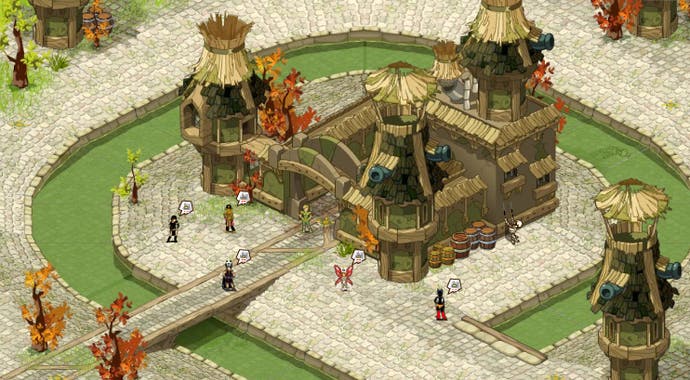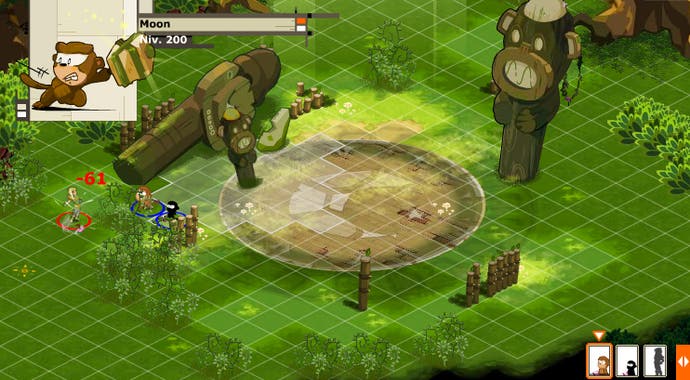Dofus
No Flash in the pan.
As names go, Dofus is not a good one. It's so bad that it suggests government intervention: a product, surely, of a dystopian future where all of mankind's work is arbitrarily assigned a title by an uncaring (and possibly malfunctioning) master computer. Ankama Studios' flagship MMO has style, charm, and an intelligent air - yet while most fantasy games go for names that suggest the promise of elaborate adventure, Dofus, a glamorous blend of both 'oaf' and 'doofus', invokes the kind of person who regularly gets their tongue caught in barbed-wire fences.
You could argue that Dofus is the worst product name ever conceived, were it not for my discovery, years ago in a foreign supermarket, of a breakfast cereal named Crapsy Fruit. Crapsy Fruit was French. So, as it happens, is Dofus. There, luckily, all similarities end.
From the sophisticated art, to the gently cerebral turn-based combat system and elegant in-browser interface, everything about Dofus suggests an MMO that confidently walks its own path. That's certainly true, but unlike Continental curios such as The Saga of Ryzom before it, Dofus doesn't appear to be paying a heavy price for its distinctive personality when it comes to finding an audience. There's a contradiction here: while MMOs like Tabula Rasa ape mainstream genres but struggle to win followers, Dofus is giddily skipping in the opposite direction, and somehow managing to get by. In fact, it's quietly thriving: according to MMOGChart.com, it's the sixth-biggest subscription MMO in the world.
Partly this is down to the ease of discovery: a very small client download, that browser interface, and a relatively large free area of play (the floating tutorial island of Incarnam and the leafy, autumnal village of Astrub) for non-subscribers. But there's more to it than that, because Dofus is a confident blend of genres, and although the results are a slower-paced experience than other titles, they also differentiate the game enough to allow it to sit alongside the giants as a companion piece rather than a direct competitor.

The Dofus themselves are six legendary dragon eggs that arouse greed and covetousness in all who search for them. The story is typical MMO fare, meaning that it's completely surplus to requirements for all but the .0001 per cent of players for which it is, somehow, luminously central to their experience. Whatever your opinion, developers Ankama have done a good job expanding the world's lore (often, cannily, with revenue in mind, as in the case of the Dofus Manga series). The game's elaborate backstory is there for whoever wants to seek it out, and while it's probably not worthwhile doing so if you're just interested in levelling up and scoring some nice clothes, it undoubtedly adds solidity to the player's world.
But Dofus' world is far more than solid - it's genuinely beautiful. The choice of Flash over a 3D engine has allowed the developers to create something uniquely personal, and each new screen presents a vista with at least a few individual touches - a tumbledown wall, a bird's nest clinging to the crags of a cliff, or even just a shapely sprouting of weeds.
For those willing to pay the £3.90 monthly subscription fee, a large and complex continent awaits them beyond the free zone. Although the setting is largely bucolic - fields, cobbled paths and trim cottages - it manages to cram in a fair amount of atmospheric variety along the way, from the threatening half-light of Sidimote Moor and the theme park balloons and sagging tents of Trool Fair, through to the lava-fortified city of Brakmar. Although the term anime is often used to describe Dofus' style, in reality it's anime shot through with a sun-faded Western disposition - its palette of ageing greens and yellows is inexplicably Continental. Dofus' players may speak in text shorthand and emoticons, but the world they traverse has an antique feel - and that's something you won't experience in many other games.

The character designs add to that wilfully different style. Up close they pay due diligence to fantasy archetypes, but from the game's normal,lofty perspective, the large community littering the fields and ridges resembles not the medieval fayre try-hards you may have come to expect, but the crowd left behind in the wake of Woodstock. They're a distinctly hippyish sight, clustered around NPCs in loon pants and beaded jackets, or kneeling (to regain HP) mid-dungeon as if recovering not from a hit from the nearest beer bong. The effect is only emphasised by their long-legged Jackson Five cartoon running as they sprint eagerly towards the next spawn point.
Of course, there's more to Dofus than fancy art and quirky design. The quests, often announced in charmingly hit-and-miss translations, are far from revolutionary in content, but are handled elegantly, with a selectable compass that points the way to the next item on the itinerary. Equally, levelling is a steady and regular process in the early stages, and the pacing of the learner areas provides plenty of ways to gain experience without getting bogged down in endless spawn-camping.


